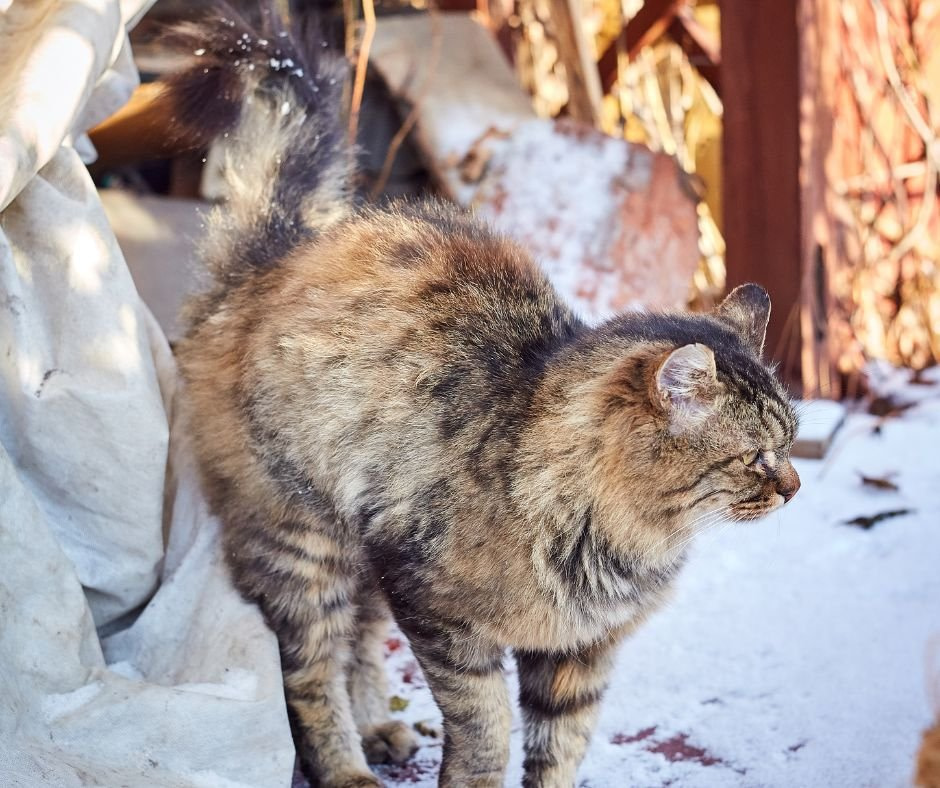When it comes to your cats behaviour, understanding the nuances between cat spray and cat pee is essential. While both involve the release of urine, the motivations behind each are distinct. Cat spray serves as a form of communication and territorial marking, while cat pee is primarily for elimination. By recognising the subtle differences in their purpose and execution, you can gain valuable insights into your cat’s needs and potentially address any underlying issues. But what exactly is the difference between spraying and peeing? Let’s explore further.
Key Takeaways
- Cat spray is for communication and marking territory.
- Cat pee is a regular elimination behaviour and contrasts with urine marking where cats release small amounts of urine to communicate.
- Cat spray is on vertical surfaces, cat pee is on horizontal surfaces.
- Posture: spray involves backing up, pee involves squatting.
- Understanding triggers aids in distinguishing between the behaviours.
Understanding Cat Spraying Behaviour
If you’ve ever wondered about the distinct behaviour of cat spraying, understanding how cats mark their territory through this unique method is essential.
Cats spray as a way to communicate with other felines and mark their territory. Behavioural triggers such as stress, anxiety, or changes in the environment can prompt this behaviour.
Environmental factors like the presence of other cats or new objects in the home can also influence a cat to spray. By releasing urine in a spray pattern on vertical surfaces, cats leave behind small amounts of urine, which is a communication signals for other cats to interpret.
Hormonal influences, such as intact male cats seeking to attract mates or female cats in heat marking their availability, can also play a role in cat spraying behaviour which may decrease significantly post neuter. Recognising these factors and signals can help cat owners better understand and address their feline companions’ spraying habits often involve leaving behind cat urine as a means of urine marking.
Differentiating Cat Spray From Urine
To tell the difference between your cat spraying vs peeing, observe whether the cat releases small amounts of urine on vertical surfaces for marking or eliminates in a squatting position for urination. The best way to tell the difference between cat spray and cat pee is to observe the location of the urine - whether on vertical surfaces like walls or horizontal surfaces like floors. Cat spray is typically found on vertical surfaces as cats use it to mark their territory or communicate with other cats. On the other hand, cat pee is commonly found on horizontal surfaces like floors or carpets as it’s a critical elimination behaviour.
When trying to distinguish between the two, look for signs such as backing up to a surface and raising the tail for spraying, while squatting in one spot signifies peeing.
Identifying triggers that lead to spraying, implementing behavioural modifications, using specific cleaning techniques, providing environmental enrichment, and seeking veterinary consultation are important steps in addressing inappropriate elimination issues.
Understanding the difference between cat spray and cat pee is essential for effectively managing and correcting these behaviours. By recognising where the urine is located, pet owners can take appropriate actions to help their cats.
Causes of Cat Spraying
Understanding the reasons behind why cats spray can shed light on their behaviour and help you address the issue effectively. Cat spraying is often triggered by hormonal factors, such as intact males marking their territory to attract mates or assert dominance. Territorial marking is a common cause, where cats use spraying to communicate ownership of their space.
Behavioural patterns play a significant role, with stress, anxiety, or environmental changes prompting cats to spray as a response. Environmental stressors like new pets or moving to a different home can lead to spraying behaviour as well. Additionally, cats use spraying as communication signals, especially in multi-cat households where they establish boundaries and convey social hierarchies.
Effects of Cat Spraying
Cat spraying serves as an essential means of communication for cats, conveying messages through scent marking. This behaviour can have various effects on owners, triggering feelings of frustration or concern due to the strong odour of cat urine and potential damage to furniture or walls. Understanding the underlying reasons for spraying is vital to address territorial instincts and environmental factors that may contribute to this behaviour.
Cats often spray in response to stress, changes in their routine, or the presence of other animals in their territory. By recognising these triggers and providing appropriate outlets for their communication methods, such as scratching posts or interactive toys and strategies to prevent a cat from spraying include neutering and providing multiple litter box options can influence a cat’s decision on where to urinate, owners can help alleviate spraying behaviours. Additionally, creating a safe and secure environment for the cat can reduce the need for territorial marking.
Seeking advice from a veterinarian or animal behaviourist can offer tailored solutions to manage cat spraying effectively and improve the overall well-being of the feline companion.
Managing Cat Spraying Issues
When addressing cat spraying issues, identifying potential triggers and providing appropriate solutions is essential to managing this behaviour effectively.
Behavioural modification techniques can be beneficial in addressing the root cause of spraying. Introducing environmental enrichment such as vertical spaces, scratching posts, and interactive toys can help redirect your cat’s behaviour towards more appropriate outlets, including preventing them from spraying or peeing outside the litter box. Positive reinforcement can be used to stop cats from spraying, like rewarding good behaviour and ignoring or redirecting unwanted spraying, can also be effective
Understanding that spraying is a form of territory marking and communication signals between cats is vital. By recognising these behaviours, you can tailor your approach to managing spraying issues. Creating a harmonious environment where your cat feels secure and content can reduce the likelihood of territorial marking through spraying and peeing outside the litter box.
Consulting with a vet or behaviourist can provide further insights and stop cats from unwanted behaviours. personalised strategies to address your cat’s specific spraying issues effectively. By implementing these techniques, you can help your cat feel more comfortable and prevent unwanted spraying behaviour.
Preventing Cat Spraying: Stop Cats Urine Marking
To prevent cat spraying behaviour, establishing a calming environment is essential in reducing stress triggers that may lead to territorial marking. Cats are sensitive creatures, and environmental enrichment plays a vital role in their behavioural well-being.
Providing your cat with plenty of vertical spaces, hiding spots, scratching posts, and interactive toys can help alleviate stress and prevent the need for territorial marking through spraying. Additionally, maintaining a consistent routine and ensuring your cat feels secure in its surroundings can further aid in stopping cats from spraying. stress reduction.
Behavioural triggers such as changes in the household, introduction of new pets, or lack of attention can lead to spraying. By addressing these triggers promptly and providing positive reinforcement for desired behaviours, you can help deter your cat from engaging in territorial marking.
Addressing Cat Pee Problems
Addressing inappropriate elimination behaviour, particularly when it involves cat pee on horizontal surfaces, requires understanding potential underlying causes and implementing appropriate solutions. When dealing with cat pee problems, it’s important to take into account the health implications.
Cat pee on horizontal surfaces may indicate health issues such as urinary tract infections, bladder stones, or kidney disease. Hence, seeking veterinary care is essential to rule out any medical conditions contributing to the behaviour.
In addition to addressing health concerns, establishing consistent cleaning routines is essential. Use enzymatic cleaners to thoroughly remove the scent of cat pee, as residual odours can attract cats back to the same spot.
Behaviour modification techniques, such as positive reinforcement for using the litter box and creating a calm environment, can help prevent future incidents and stop your cat from spraying indoors. Consider providing different litter box options, such as covered or uncovered boxes, to see which your cat prefers.
Comparing the Difference Between Cat Spray and Cat Pee
Understanding the distinction between cat spray and cat pee is essential for effectively managing feline elimination behaviours. Behavioural differences between the two include the fact that cat spray is a deliberate act used for communication and territory marking in cats often involves urine marking to signal to another cat., while cat pee is a regular elimination behaviour.
Location indicators play a significant role in differentiating the two; cat spray is typically found on vertical surfaces like walls, whereas cat pee is more commonly seen on horizontal surfaces such as floors or carpets. Posture analysis can also help discern between the two behaviours. Cats often exhibit specific body postures when engaging in spraying versus regular urination.
Through their communication methods, cats use spraying to mark their territory or convey messages to other cats, whereas peeing serves a functional purpose in cat spraying vs peeing includes communication and territory marking versus elimination behaviour.. Recognizing these distinctions is important for accurately identifying the issue at hand and implementing appropriate solutions to address any behavioural concerns related to territory marking or inappropriate elimination.
Frequently Asked Questions
Does Cat Spray Smell Different Than Urine?
When your cat sprays, the smell is distinct from regular urine. It contains pheromones, giving it a musky odour. To differentiate odours, use enzymatic cleaners. Address behavioural reasons and consider health implications. Training solutions can help manage spraying behaviour.
How Do I Know if My Cat Peed or Sprayed?
To distinguish if your cat peed or sprayed, observe for squatting or backing up, location, and the type of urine. Use enzyme cleaners for cleaning. Understand that spraying is for marking territory, triggered by stress. Implement preventive measures like spaying/neutering.
How Long Does Cat Spray Smell Last?
Cat spray smell can linger for up to two weeks, with pheromones lasting longer. Proper cleaning with enzymatic cleaners is key. Factors like humidity affect intensity. Seek professional help if odour persists despite efforts.
Do Cats Spray Pee in the House?
If your cat is spraying pee in the house, start by ruling out medical reasons. Then, consider training methods, suitable cleaning products, behaviour modification techniques, environmental enrichment, and consulting a vet for guidance on spraying in the house and how to stop a cat from peeing outside the litter box. Addressing issues promptly is key.



